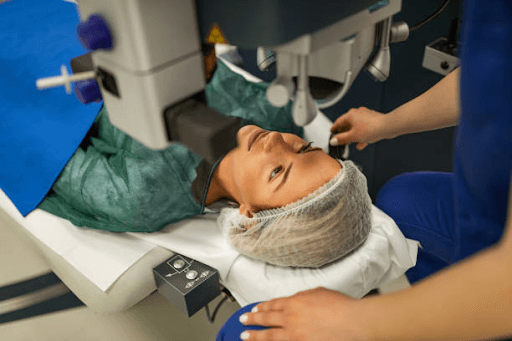Laser eye surgery transforms lives. Among its types, LASIK stands out as a front-runner. Patients need to grasp the science that empowers this vision-correcting marvel.
What is LASIK?
LASIK stands for Laser-Assisted In Situ Keratomileusis. This advanced procedure has seen significant evolution in terms of technology and technique since it first came into practice. Its primary function is to correct common vision problems.
When we talk about nearsightedness or myopia, it means having difficulty seeing distant objects clearly. Farsightedness, known as hyperopia, is the opposite – trouble with close-up vision. Then, there’s astigmatism, which causes overall blurry vision due to an irregularly shaped cornea.
The procedure works by reshaping the cornea, which is the clear front part of the eye. This is where light enters and is focused, allowing us to see. If the cornea’s shape isn’t just right due to the above-mentioned conditions, one’s vision becomes cloudy or distorted.
LASIK uses precise lasers to sculpt the cornea into the proper shape to correct these imperfections. This particular surgery modifies how the eye directs light onto the retina, which is located at the back of the eye, a process essential for achieving sharp vision.
LASIK is highly sought after as it offers a sustained remedy for vision correction, greatly diminishing and, in numerous instances, completely negating the dependence on glasses or contact lenses for individuals who opt for this surgical intervention.
It promises an improved quality of life, with many patients experiencing significant improvements in their vision, often noticing the difference almost immediately after the surgery.
The Pre-operative Process
A good LASIK outcome starts with selecting suitable candidates. Eye health, sufficient corneal thickness, and stable prescriptions are crucial. Doctors use corneal mapping to ensure precision in the procedure ahead.
The journey to successful LASIK surgery begins well before the operation itself. Here’s what the pre-operative process entails:
Candidate Selection
This is the first and one of the most critical steps. Not everyone is a candidate for LASIK, so specialists must conduct an initial evaluation to identify suitable patients.
- Eye Health Assessment: Doctors assess the overall health of the eyes. They screen for any conditions that could compromise the surgery or healing process, such as chronic dry eyes or corneal diseases.
- Corneal Thickness Evaluation: LASIK surgery involves reshaping the cornea; enough tissue must be made to make the necessary adjustments safely. A minimal corneal thickness is essential to proceed.
- Prescription Stability Check: To ensure the long-term effectiveness of LASIK, the patient’s prescription for glasses or contact lenses should be stable, with no significant changes for at least a year before the procedure.
Advanced Diagnostics
With candidacy confirmed, doctors gather detailed information about the eyes.
- Corneal Topography: This mapping gives a detailed image of the cornea’s shape and contours. It is vital for planning a precise and customized surgery.
- Pachymetry: This measurement provides the exact thickness of the corneal tissue, contributing to the safe planning of the surgery.
Wavefront Analysis
For some candidates, wavefront technology creates a three-dimensional map of how light travels through the eye. This analysis can identify unique visual aberrations that can be corrected during surgery.
Pre-Surgery Instructions
Candidates receive detailed guidelines to prepare for surgery.
- Medications and Supplements Review: A thorough review of the patient’s medications and supplements is necessary to rule out any that might affect the surgery or recovery process.
- Lifestyle Guidelines: Patients might be advised to abstain from certain cosmetics, lotions, or perfumes before surgery. They may also receive recommendations to stop wearing contact lenses for a period before the procedure to ensure the cornea is in its natural state.
- This careful planning aims to enhance the precision of the LASIK procedure and optimize the conditions for a successful outcome and rapid recovery. It underscores the importance of customization and meticulous attention to detail in achieving each patient’s best possible vision correction.
The LASIK Procedure: A Step-by-Step Explanation
During LASIK, surgeons create a thin flap in the cornea. Here, they can choose between a blade called a microkeratome or a bladeless femtosecond laser. The next phase involves an excimer laser, which meticulously removes corneal tissue, reshaping the cornea to correct vision.
The LASIK procedure can be divided into the following detailed steps:
- Preparation: Patients undergo a thorough eye examination. They receive numbing eye drops and may be given medication to help with relaxation.
- Creating the Corneal Flap: The surgeon uses a precise instrument, either a microkeratome or a femtosecond laser. This is to create a thin flap on the cornea’s surface.
- Reshaping the Cornea: With the flap lifted, the surgeon employs an excimer laser to sculpt the underlying corneal tissue. The laser is uniquely programmed for each patient’s specific refractive error.
- Repositioning the Flap: The surgeon carefully moves the corneal flap back onto the underlying tissue after the cornea is reshaped. It adheres naturally without the need for stitches.
- Recovery: The patient rests for a short time post-procedure. Recovery instructions are provided, and follow-up appointments are scheduled to monitor the healing process.
During these steps, state-of-the-art technology tracks the eye’s movements to ensure laser accuracy, and surgeons skillfully manage the laser to ensure optimal corneal reshaping. This precise alteration of the corneal shape allows for correcting visual defects like myopia, hyperopia, and astigmatism.
The Role of Technology in LASIK
Technology is vital in LASIK’s success, especially wavefront technology that maps the eye in 3D. This mapping allows for custom LASIK, a procedure tailored to individual eyes, enhancing success rates.
Post-operative Care and Recovery
After the procedure, patients may experience discomfort or vision disturbances, but these usually subside quickly. The recovery period demands strict adherence to the surgeon’s aftercare instructions to promote healing and mitigate infection risks. Most patients notice significant vision improvement within 24 hours, and the recovery process continues progressing over the following weeks.
The Risks and Complications
Like all surgical procedures, LASIK comes with potential side effects such as dry eyes or night-time glare. Serious complications are rare and often manageable when following professional guidance. Advancements in technology have significantly minimize these risks, leading to enhanced safety profiles for LASIK.
The Science of Healing: What Happens Post-Surgery
After a LASIK procedure, the patient enters a crucial healing phase. The corneal flap, created and lifted during surgery, starts to bond naturally with the underlying corneal tissue — this occurs without the need for sutures. The eye’s inherent healing processes begin immediately after the surgery.
In the days following the procedure, it’s common to experience some discomfort or sensitivity to light, but these symptoms typically resolve quickly. Patients are often advised to use antibiotics and anti-inflammatory eye drops to support healing, prevent infection, and reduce inflammation.
As healing progresses, the cornea steadily conforms to its new curvature. The success of this adjustment is critical in improving the patient’s vision. For most patients, vision improves dramatically within 24 to 48 hours after surgery.
However, it’s important to note that complete stabilization may take a few weeks to several months as the eye fully adapts to its new contour.
LASIK Success Rates and Prognosis
LASIK boasts high success rates, with many patients achieving 20/20 vision or better. Factors determining success include pre-existing eye conditions and the expertise of the surgeon. Most enjoy long-term results, though some may need reading glasses as they age due to a condition called presbyopia.
The Future of LASIK
The horizon for LASIK is bright, with ongoing research to refine techniques and expand candidacy. Innovations continue to enhance precision and outcomes, offering hope for even better vision correction solutions in the future. Researchers relentlessly work towards methods that will simplify the procedure further and ensure that more people can benefit from it.
The current exploration in the field of laser eye surgery promises to usher in a new generation of procedures that could make LASIK available to those who currently do not qualify. The scientific community remains keen on reducing recovery time and the already low risk of complications.
Conclusion
LASIK stands as a pinnacle of medical science’s triumph over vision impairment. With a strong understanding of the procedure and adherence to pre- and post-surgery protocols, patients can expect to join the millions who have witnessed life-changing results. It is pivotal, however, to always seek comprehensive information and a skilled eye surgeon when considering LASIK.
Remember, empowered with knowledge, patients can make informed decisions about their vision correction options. LASIK, a blend of medical expertise, science, and technology, offers many a clear future.



